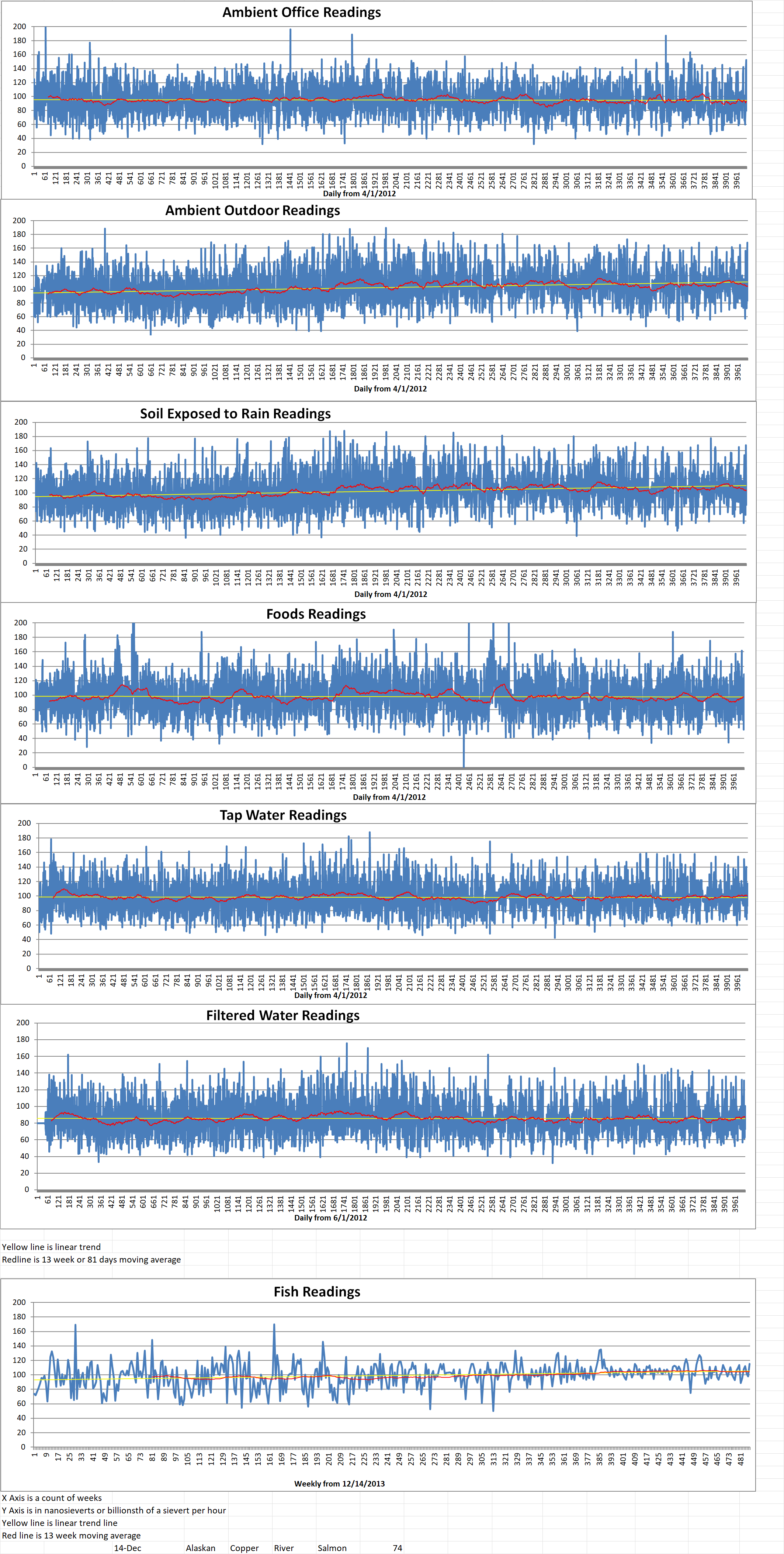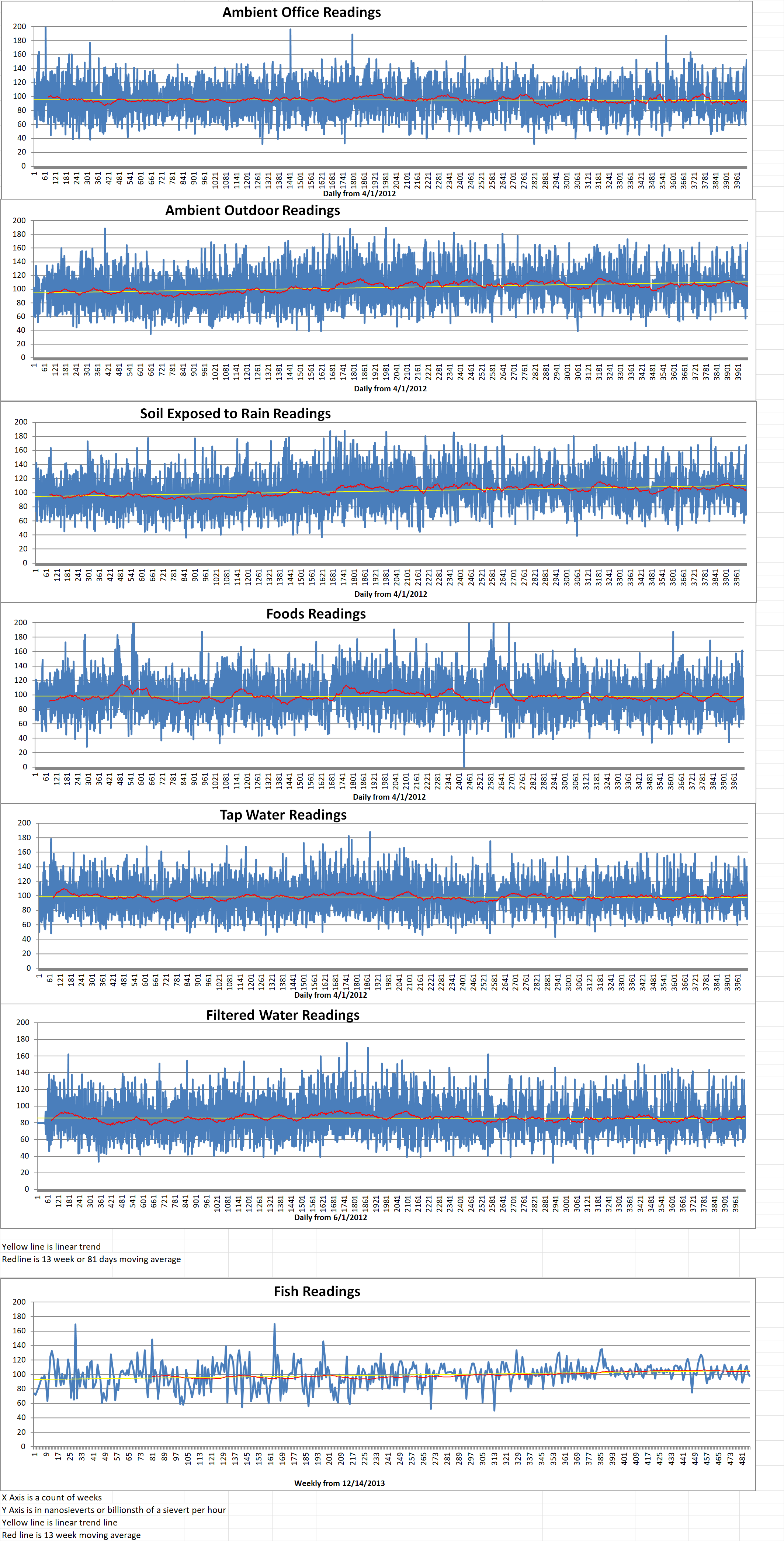Blog
-

Geiger Readings for July 02, 2023
Ambient office = 73 nanosieverts per hour
Ambient outside = 116 nanosieverts per hour
Soil exposed to rain water = 118 nanosieverts per hour
Bannana from Central Market = 165 nanosieverts per hour
Tap water = 104 nanosieverts per hour
Filter water = 89 nanosieverts per hour
-
Nuclear News Roundup July 01, 2023
Lukashenko: I have veto over use of Russian nuclear weapons in Belarus jpost.com
IAEA: Europe’s largest nuclear power plant regains back-up electricity feed news.un.org
Georgia’s new nuclear plant is expected to make a dent in state’s carbon emissions npr.org
Ukraine spy chief says nuclear threat at Zaporizhzhia plant subsiding reuters.com
-

Geiger Readings for July 01, 2023
Ambient office = 80 nanosieverts per hour
Ambient outside = 100 nanosieverts per hour
Soil exposed to rain water = 100 nanosieverts per hour
Avocado from Central Market = 129 nanosieverts per hour
Tap water = 87 nanosieverts per hour
Filter water = 73 nanosieverts per hour
Dover Sole from Central = 115 nanosieverts per hour
-

Nuclear Reactors 1241 – Spanish Politicians Argue Over Plan To Close All Spanish Nuclear Power Plants by 2035
Alberto Núñez Feijóo is the leader of Partido Popular in Spain. He recently made a commitment to extend the lifespan of the country’s seven nuclear power plants. Teresa Ribera is the Spanish Ecological Transition Minister. She said last Tuesday that Feijóo commitment is a political slogan and a tricky message. She went on to say, “It is not enough with a slogan it is not enough to say: ‘I extend’, at whose expense, who pays, the State, the consumers? Because at the end of the day that is the implicit message.”
On last Monday, Feijóo proposed that, if the PP wins the general election on the 23rd of July, the planned dismantling of the seven Spanish nuclear power plants will be canceled and their lifespans extended.
In the view of Ribera, Feijóo’s proposal is a political tactic marked by the upcoming election campaign which begins next week.
Pedro Sánchez is the current Spanish Prime Minister. He asked the PP leader who would pay the enormous priced that would be involved in implementing Feijóo proposal. Sanchez said in a recent interview, “The question the PP is not answering is: Who will pay for it: the citizens or the State?” Because if you look at the energy sector in the long term, the cost of producing electricity by nuclear power is much more expensive than renewables. They will have to explain who will pay.”
The Socialist Prime Minister recalled that Minister Ribera agreed in 2019 with the companies that own the Spanish nuclear power plants on a schedule for closure until 2025. He regretted that Feijóo did not make “any proposal on energy linked to the ecological transition”.
The plan approved by the Socialist government in 2019 states that the closure of the seven Spanish nuclear power plants would take place in several stages. It will run from 2027 until 2035 by which time all the plants would be shut down. The closure plan for the nuclear power plants would follow the schedule of the Almaraz I in 2027, the Almarex II in 2028, the Ascó I and Cofrentes in 2030, the Ascó II in 2032 and the Vandellós II and Trillo in 2035.
Ribera is number 2 on the PSOE’s list for Madrid for the July 23rd general election. She said that the promise made by Feijóo is a “trick message”. Ribera recalled that it was the nuclear companies that managed the nuclear power plants themselves that “at the time reached an agreement to (set) a timetable for closure (until 2035)”. The Spanish government is willing to invest in nuclear safety but not to extend by a few years the lifespan of the nuclear plants.
Ribera said, “We are not prepared to invest large sums of money for something that has a limited lifespan, which, if it is exceeded in time, requires a much larger amount than we are prepared to maintain.” On the other hand, she assured that “what is most appropriate for this country, with affordable, stable, predictable (energy) prices for consumers, but also with returns for investors, are renewable (energy) solutions”.
Ribera concluded that “Spain is rich in renewable (energy) alternatives, and it is rich in human capital, in will, in companies and societies that know how to take advantage of the opportunities for innovation, employment and industry linked to renewables. We have become a very important focus of attraction for investment.” -

Geiger Readings for June 30, 2023
Ambient office = 81 nanosieverts per hour
Ambient outside = 84 nanosieverts per hour
Soil exposed to rain water = 83 nanosieverts per hour
Tomato from Central Market = 52 nanosieverts per hour
Tap water = 91 nanosieverts per hour
Filter water = 81 nanosieverts per hour
-
Nuclear News Roundup June 30, 2023
Ontario government announces support for nuclear expansion world-nuclear-news.org
New satellite images show unidentifiable shapes at Ukraine’s Zaporizhzhia nuclear plant news.sky.com
Russia begins new isotope product supply to India world-nuclear-news.org
Top Zelenskiy adviser: China’s position on Russian nuclear threat ‘important’ reuters.com
-

Nuclear Reactors 1240 – Korea Hydro & Nuclear Power Signs Deal With Romania Nuclear Operator For Tritium Removal Plant Construction
Korea Hydro & Nuclear Power (KHNP) has signed a contract worth two hundred million dollars to construct a tritium removal facility at the site of Romania’s Cernavoda nuclear power plant. The Romanians developed the technology that will be used at the new facility.
Hwang Joo-ho is the CEO of KHNP. Cosmin Ghiță is the general manager of Romanian nuclear power plant operator Societatea Nationala Nuclearelectrica (SNN). The two men signed the engineering, procurement and construction (EPC) contract in Seoul on the 27th of June.
As Candu pressurized heavy water reactors age, tritium accumulates in their moderator and heat transport systems. Tritium is a radioactive isotope of hydrogen with one proton and two neutrons in the nucleus. Increased levels of tritium can significantly contribute to personnel dose rates of radioactivity and radioactive emissions levels in the environment. Tritium removal technology is designed to capture and process tritium so it can be properly stored. This process reduces environmental impact, personnel exposure levels and enhances workplace safety.
The Cernavoda tritium removal facility will be the world’s third such facility and the first one in Europe. The technology that will be used was developed by the Romanian National Research and Development Institute for Cryogenic and Isotopic Technologies (ICSI). The ICSI is a scientific research and technology development unit under the coordination of the Ministry of Research, Innovation and Digitalization.
The new tritium removal facility will include several high-technology areas. These include liquid phase isotopic separation, cryogenic distillation, and high-vacuum operations. The extracted tritium will be stored in secure and safe specialized containers ready for future use.
The SNN said that the facility will “give Romania the opportunity to become a European hub for tritium production and export – the fuel candidate of future clean fusion reactors. Also, Romania has the opportunity to develop its suppliers’ chain and become a center for development and export of the Romanian tritium removal technology and know-how, using localized factories and workforce”.
KNHP was selected as the EPC contractor after a public procurement process. It is estimated that the project will be completed in fifty months.
Ghiță said, “We are happy to implement a Romanian innovative technology, based on years of research and development, a true statement of Romania’s leadership in nuclear industry. KHNP, a leading expert in the field is the right partner to support us in delivering a safe and reliable project. The tritium removal facility represents Nuclearelectrica’s constant commitment to safe operation and protection of the environment and population. Our purpose, through our investment projects, technological advancement and international cooperation, is to provide Romania a leading role in the nuclear industry and support its energy security. I am fully appreciative of ICSI, my team at Nuclearelectrica and our partners for their efforts and shared vision for a sustainable future for the next generation.”
Currently, Cernavoda is the only operational nuclear power plant in Romania. It consists of two six hundred and fifty megawatt Candu-6 reactors. Reactor One went into commercial operation in 1996 and Reactor Two went operational in 2007. SNN is working on extending the life of Reactor One to sixty years. Tritium removal facilities are already in operation at the Ontario Power Generation’s Darlington plant in Canada and KHNP’s Wolsong plant in China. -
Nuclear News Roundup June 29, 2023
Warnings raised about tritium levels at Chinese nuclear plants taiwannews.com
UN nuclear agency endorses Japan’s plan to release treated radioactive water into the Pacific Ocean apnews.com
Kremlin denies China’s president urged Putin not to use nuclear arms in Ukraine theguardian.com
Ukraine holds disaster drills amid fears Russia could sabotage nuclear power plant abcnews.go.com
-

Geiger Readings for June 29, 2023
Ambient office = 94 nanosieverts per hour
Ambient outside = 88 nanosieverts per hour
Soil exposed to rain water = 84 nanosieverts per hour
Strawberry from Central Market = 80 nanosieverts per hour
Tap water = 117 nanosieverts per hour
Filter water = 101 nanosieverts per hour
